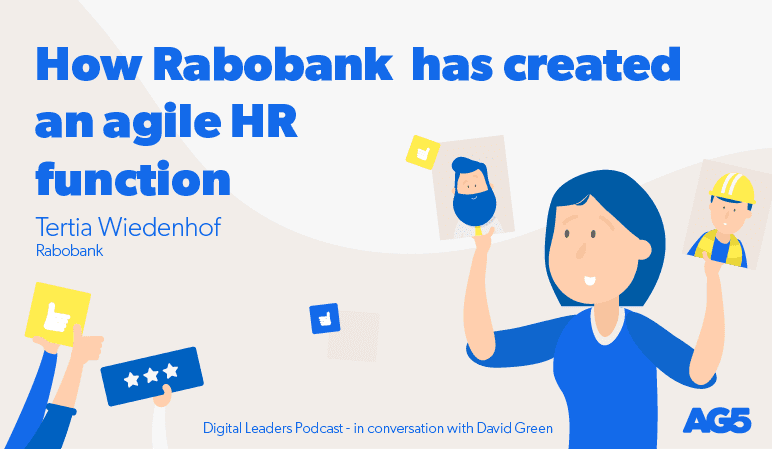Agile & data-driven: A case study on Rabobank’s new HR Function
In this article we explore Rabobank’s revamped HR function. It discusses the objectives, structure, and potential impact of this organizational change on Rabobank’s HR practices and operations.

In this AG5-sponsored Digital HR Leaders podcast, David Green talks with Rabobank’s Global Leader and Product Owner for the People Analytics and Insight Team, Tertia Wiedenhof about the benefits that come from running an agile HR.Copied
Rabobank is one of the first banks to shift to agile ways of working, and it is now well on its way to transforming into a fast-moving digital co-operative. This move reflects the changing needs of customers, the advances of new technology, and changes to the ways of work. This article offers a quick introduction to agile working and then runs through all these discussion points:
- Rabobank’s move toward agile working
- Why an agile HR needs to be driven by data
This article is a must-read for anyone who is considering making the shift toward agile working in their organisation. Or for anyone who wants to learn about the benefits of running a data-driven HR.
Agile working: a quick overview Copied
You may have heard the term agile working already. But for those who haven’t, it is the practice of allowing more flexibility to practice finding the most appropriate and effective ways of working. The official definition, as put forward by the Agile Organization, is as follows:
“Agile working is about bringing people, processes, connectivity, and technology, time and place together to find the most appropriate and effective way of working to carry out a particular task. It is working within guidelines (of the task) but without boundaries (of how you achieve it).”
For an HR department to become agile, it needs to be able to provide the same services but in ways that are responsive to change. When HR fully adopts agile working and takes on this new mindset the benefits, as Rabobank found, are great.
Rabobank’s move toward agile workingCopied
Rabobank decided to shift toward agile working in response to the many market changes recently. New technologies have emerged, customer needs changed, and there has also been an influx of newcomers joining the banking world. To continue to be effective, Rabobank recognized it needed to be flexible and adaptive to change. It needed to run multi-skilled teams. It needed to go agile.
HR wasn’t the first function at Rabobank to make the shift to agile, and it certainly won’t be the last. But now that HR has taken on this new way of working, future changes will be much easier to make as the bank now has sound data to rely on. This data comes from the coupling of HR with people analytics to form the new agile multi-skilled function.
“For me, agile HR, working agile and people analytics, goes hand in hand. If you want to do work in HR properly as HR, you really want to know what employees need, what they want, what problems they have during the day, that you can solve as HR.” (Tertia Wiedenhof, Rabobank)
Why a data-driven and employee-centric HR function is so important
In the past HR departments tended to think for their employees. Now that HR at Rabobank is working alongside people analytics, they are better equipped to think about what problems employees have. Decisions can be made based on data and guided by the needs of its employees.
Much like any other analytic team, an agile HR must center its target audience. As its focus is employees, it is the employees’ vision that needs to be at the heart of things. HR at Rabobank is specifically interested in how teams and individuals are looking to develop themselves. It is engaged with every individual’s progress and ambitions. It is interested in what they want to learn and where they want to grow. Rabobank is passionate about having all employees in their company thrive. It is also dedicated to providing space for curiosity; it wants each employee to be part of their own decision-making when it comes to individual development.
How HR is becoming more vocal in major decision making
It is now common to see HR at the table with senior management operating at a more strategic level. It is the job of HR to ensure that senior management knows precisely what their employees’ needs are. It is also HR’s job to make sure senior management skill their teams efficiently so they can do their work in an outstanding way. As a bank, Rabobank has a lot of knowledge workers, so the employees really are its capital. There is then, even more, need to have a grasp of every employee’s skills and needs.
Now that Rabobank has a multi-skilled HR department that brings data to the tables, decisions can be grounded by facts. Rabobank’s HR is no longer dealing with hearsay, it can pinpoint exactly what works and what doesn’t. The data that the function generates can now be fed into major decision-making and ensures that employees’ needs are continually met.

Why an agile HR needs to be driven by dataCopied
While the knock-on effect of being data-driven is inspiring top-level leaders, the biggest impact it has had is with HR’s daily operations. Rabobank’s HR function now has an extensive pool of data that reflects its employees’ voices. The direction and decisions now made can be impactful, every time. It is also inspiring trust from the company’s workforce – they are seeing changes made that they themselves have asked for. This creates a snowball effect, as employees become a lot more willing in the future to take part in the surveys used for data collection. They are more confident that we will do our best to accommodate their needs.
The value of measuring skills data
When it comes to tracking and developing employees’ skills, the key is to make it simple. The starting point should always be with an employees’ problem. Only once you know the problem can you start to tackle it. Being data-driven allows Rabobank’s HR function to pinpoint the root of the issue – it can see whether it’s a skills issue, for instance. If this is the case, they can easily spot this and get training in place early on.
Measuring skills data also allows Rabobank to be forward-thinking. It can match training activities to ready people for the future. With so much value placed on the employee, Tertia iterated that Rabobank is committed to their needs and not just the bank’s. It makes sure that all training activities are suitable for every employee. This is why it makes its skills data accessible, so employees can be fully involved in their own developments.
How a Skills Management Software helps measure HR data
Copied
Becoming data-driven and agile naturally means having more data to handle. However great platforms such as Excel are, they are easily overburdened by this amount of data. Spreading the data across multiple spreadsheets can be a clumsy alternative as it decentralizes all information, making it harder to handle. AG5 Skills Management Software brings all of your skills data into one hub so you can easily visualize and close your staff’s skills gaps.
When decision-making is based on data you need it accessible and ready whenever you are. This is what AG5 ensures. HR, Training, and Operations Managers will always be equipped with a clear overview of their staff’s skills and qualifications. By running AG5 Skills Management Software, companies also ensure compliance and audit readiness. So not only does our software drive operational excellence, but it also ensures safety.
You can take a look at the entire episode here.

